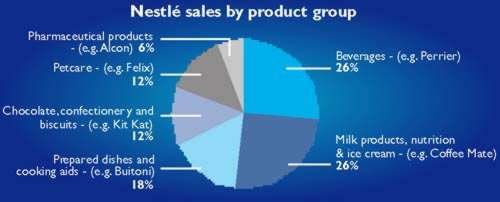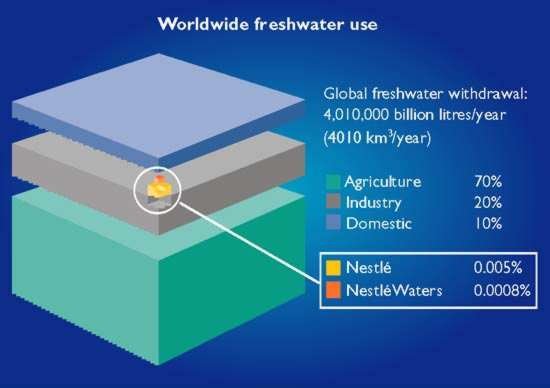Intelligent businesses in the 21st century operate with an awareness of their responsibilities to all of their stakeholders, not just responsibilities to directors and shareholders, but also to customers and, perhaps most importantly, the environment. For Nestlé, this is nothing new. From its founding in 1867 by Henri Nestlé – who developed the first cereal-milk food for infants – Nestlé has built its business on the basis of sound principles. The business is committed to creating value for all stakeholders and recognises that different stakeholders see different values as important.
The major stakeholders in Nestlé are:
- shareholders, who want a dividend from profits
- employees, who want job security and the necessary training and development to allow them to further their careers with Nestlé
- consumers, who want products that better meet their needs, that are available in the right places and at the right price
- business partners, who want long-term and trusted relationships
- local and national economies within which Nestlé operates.
This Case Study examines Nestlé’s policies on eco-efficiency and sustainability, and, in particular, how it has developed a responsible policy towards the use of water. This is covered in its first water review ‘Nestlé and Water: Sustainability, Protection, Stewardship‘ published in 2003.

Background

Nestlé is the world’s largest food and beverage company and employs over a quarter of a million workers. It is the secondary sector at the centre of the supply chain that starts with producers of agricultural products in the primary sector and ends with distribution and retailing in the tertiary sector.
Ownership
Nestlé SA acts as a holding company. SA is the Swiss equivalent of a UK public limited company (plc). Like all companies, it has a duty to provide returns to its shareholders in the form of dividends. Nestlé balances this against the need for growth whilst continuously improving and being true to its principles of sustainability. Nestlé UK is a private limited company (Ltd), wholly owned by Nestlé SA. However, Nestlé UK has its own directors and can make many of its own decisions; this is because Nestlé strives to be as decentralised as possible – local decisions are made locally.

Nestlé produces over 100 brands, including many household names such as Nescafé, KitKat and Nesquik. Other brands are also well known, but you might not have realised that they were Nestlé products – such as Golden Grahams, Buitoni, Friskies and Perrier. In 2002 Nestlé had a sales turnover of over £38.3 billion on which it made a net profit of over £3.2 billion. The majority of this profit (63 was re-invested in the business whilst the remainder was paid out to shareholders in dividends. Its attitude to growth is that it, too, should be sustainable, and this usually means organic growth. However, its water business – known as Nestlé Waters since 2002 – has grown both organically and by acquisition. Nestlé acquired Vittel in 1969, Perrier in 1992 and San Pellegrino in 1998. Today, Nestlé Waters is established in 130 countries and is the world’s leading bottled water business.
Acting responsibly

Nestlé feels that it has a real role to show a lead in acting responsibly with its business partners, suppliers and customers around the world. Responsible business practices don’t just make moral sense; they make good business sense. The company has therefore developed policies and principles to help it meet its general aims of fairness, honesty and concern for people. Its Corporate Business Principles includes all nine principles of the United Nations Global Compact referring to labour standards, human rights, and the environment which are applied throughout the company.
Some of the basic Nestlé values and principles are to:
- prefer long term development over short term profit
- develop long term commitments and relationships with suppliers and customers
- show respect for diverse cultures and ensure operations integrate with them
- recognise that consumers deserve information about the products they buy and the company behind the brand
- encourage all employees, led by senior management, to follow these principles by integrating them into Nestlé’s business processes.
Nestlé and sustainable development
Nestlé defines sustainable development as “the process of increasing the world’s access to higher quality food, while contributing to long-term social and economic development, and preserving the environment for future generations”. Nestlé tries to be a genuine partner in sustainable development. The rise in the world’s population means there is an increased demand for food. This in turn places pressure on water and raw materials produced by the primary sector. If Nestlé wants its business to continue growing it must encourage more production of better quality raw materials from its suppliers. Recognising that others face this issue, Nestlé created the Sustainable Agricultural Initiative with other food manufacturers. The group defines sustainable agriculture as “a productive, competitive and efficient way to produce agricultural raw materials, while at the same time protecting and improving the natural environment and social/economic conditions of local communities”. They recognise that this will take time, but by co-operating these competitors are better placed to make an impact on a global scale.
The basic economic problem
Economists distinguish between wants and needs; needs are those things which people require to survive. These comprise food, water and protection from the elements in the form of shelter and clothing. Nestlé products fall into two of these categories (food and water). However, they can only be described as wants because it is possible to survive without consuming any Nestlé products at all.

All resources are considered scarce because the wants for them (the demand) outstrip the various uses for them (the supply). This means that they have to be shared out (distributed) by a mechanism such as price. There are numerous ways in which a resource may be used, an opportunity cost is therefore created whenever one use is preferred over another. If water is used for industrial production, it is not available for agriculture or domestic consumption. Water is a classic example of the distribution problem of scarce resources. There is actually enough water in the world for everyone’s needs, and it is not a resource that is ever ‘used up’ in the way that other resources can be consumed. The amount of water in the earth’s water cycle – evaporating from the sea, then falling as precipitation over land – is constant, the problem is one of distribution – it is not always located where it is needed.
Factors of production
The factors of production are:
- land – natural resources including water and the proportion of the planet given over to agriculture producing raw materials
- labour – the human effort involved in production
- capital – the money invested in business including equipment purchases
- enterprise – the process of bringing the above factors together to make a profit.
Any production process involves the use of all factors of production. The efficient and sustainable use of factors of production has long been tackled by Nestlé working with its agricultural suppliers. Nestlé helps suppliers in developing countries to increase their output. For example, in Pakistan sales of milk per farmer have doubled in the last three years as a result of the support from Nestlé Agricultural Services provided to more than 115,000 farmers.

Despite consuming only a tiny proportion of water, (see table) Nestlé still seeks to minimise water use. 70% of water usage is by agriculture, and agricultural raw materials provide the basis of Nestlé’s finished products. It is important that the environment in which raw materials are grown is safeguarded and protected in a sustainable manner. Nestlé does not own farms but encourages sustainable agricultural practices amongst its suppliers. The company invests over £45 million per year in environmental protection, amounting to 3% of total capital expenditure on top of regular capital-investment projects that incorporate environmental components and factory environmental operating costs. Also, in certain parts of the world, Nestlé has invested in water education programmes and community initiatives to develop sustainable and safe water supplies. It partners EcoLink – a non-profit-making, non-government environmental education trust – in a water tank project to provide a reliable source of clean water to many South African communities. For example, in the Nkomazi and Nsikazi areas 20 water tanks have been provided at various women’s groups and schools reaching over 10,600 people. For more information see www.nestle.co.uk/studentissues and follow the links to Nestlé in the Community and the Ecolink page.
Nestlé uses water in manufacturing (for example to wash raw materials). It limits the use of water in its various operations and, where this is not possible, re-uses or re-cycles waste water.
Limiting water usage/wastage
Between 1997 and 2001 Nestlé’s volume of production increased by 32% but the amount of water used in production was actually reduced. For example, Nestlé’s Harrismith plant in South Africa achieved savings of around 40% through recovery of water generated by evaporation and tight controls on the municipal water supply. Nestlé achieved a 12% reduction in wastewater production in the period 1997-2001. From 1993-1999 the company built 38 new wastewater treatment plants and 120 plants were upgraded.
Costs and benefits
The examples above involve large amounts of investment in capital equipment. Nestlé invests over £43 million per year for the protection of the environment in its factories, with 30% of this applied in the water area. Nestlé takes a long-term perspective on gaining a return on this investment, for sustainable growth and improvement in efficiencies. Another cost which shows Nestlé’s commitment to improvement is the team of over 200 auditors employed to check that the business is complying with its own Corporate Business Principles. Nestlé’s internal communication system includes an intranet, on which the Principles are published. There is also a cost attached to the external communication of ‘spreading the message’ e.g. the report referred to above. One benefit is that employees see Nestlé as a good business to work for. The annual employee turnover rate is just 5%. In 2001 a European survey of recent business school graduates ranked Nestlé as 13th most desirable company to work for.

Nestlé also benefits in dealings with partners, suppliers and also from consumers – who are more likely to deal with or purchase from a business that they recognise as being responsible. Nestlé grows by acquisition – buying other companies as well as by organic means i.e. selling more of an enlarged portfolio of products. The growth potential of the business is also enhanced if companies it wants to buy see Nestlé as a responsible purchaser of other businesses.
Conclusion

Nestlé is not complacent about its position, it still means to go forward, developing new policies and initiatives on eco-efficiency, responsible business practice and sustainability. Nestlé will also work with national and international bodies to improve sustainability. For example, the 2002 World Summit on Sustainable Development set a target to decrease by half the number of people without access to safe drinking water by 2015: Nestlé will share its knowledge with others to help reach this goal. Nestlé will continue to protect water, increase the efficient and responsible use of water and encourage its partners and stakeholders to use water in a responsible way.
